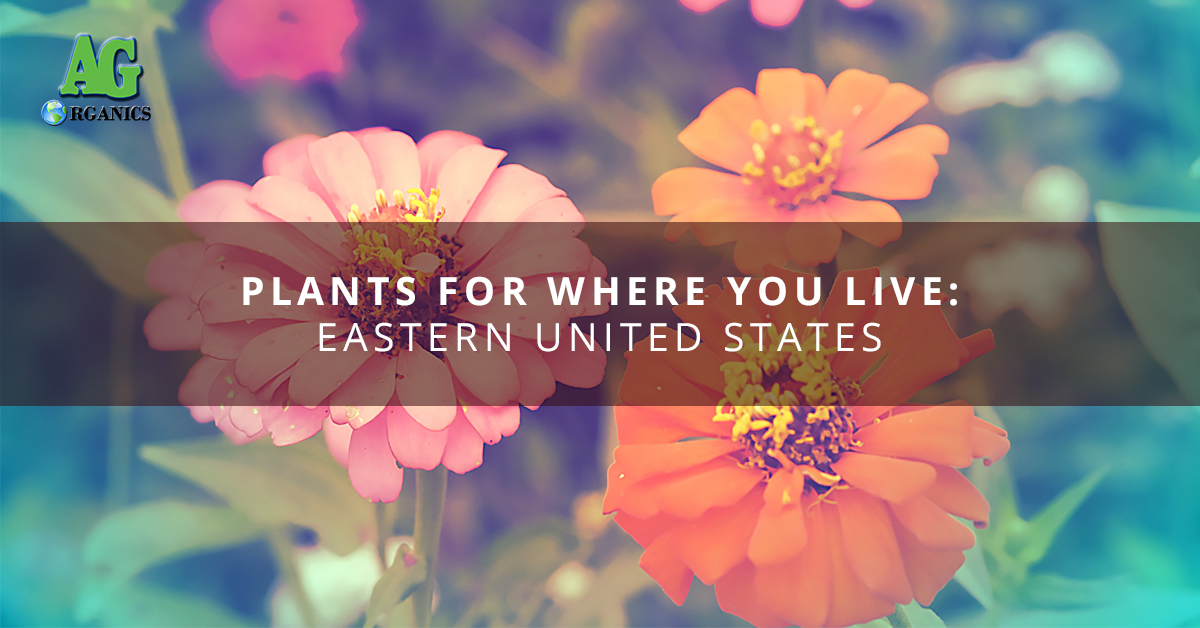Flowers of the United States: The East and Midwest
Jun 28th 2017

Want to start planting flowers? Here are what flowers grow best in your region
Hello! Welcome back to AG’s blog where we’ll regularly shower you with helpful tips and tools to assist you in creating your dream garden. Today, we’ll talk about the flowers that flourish best dependent on the region that you’re living in. If you’re residing in the Northeast region of the United States, then the flowers that will thrive best in your organic garden are likely going to be different than in those blooming in the Southwest. If you’re new to flower gardening, check out this comprehensive list that will point you in the right direction of what flowers to grow in your garden.
Today, we’ll focus on the regions that exist towards the east of the United States including the Northeast, Mid-Atlantic, Midwest, and Southeast.
Northeast
The states in the Northeast are no stranger to blizzards, thunderstorms, and other unpredictable weather patterns. But, they’re also known for woodsy cottages and rocky beaches. Because these states experience four seasons, it’s best to plant your garden with flowers that can not only withstand the northeastern climate, but will also still compliment your Northeastern style home.
- Wild Anemone: The white petals and yellow center of the Wild Anemone make the flower a lovely addition to your garden. It usually grows up to about 2 feet in height and favors the partly cloudy skies that the Northeast commonly experiences.
- Carolina Lupine: The Carolina Lupina stands tall and bright and adds the perfect burst of color to both flower heavy gardens and shrubs alike. The bright petals are comparable to beads and pop out all over the stem. The ideal conditions for the Carolina Lupina are plenty of sun and porous soil. Sprinkle some of our recommended organic fertilizer for added growth and color.
- Woodland Iris: The features of the Woodland Iris are its shooting leaves and delicate blue flower. With the flower’s name being an accurate description, the Woodland Iris is the perfect addition if you’re going for a natural, wild garden.
Mid-Atlantic
The Northeast may put up a fight and the Mid-Atlantic region isn’t too different than their neighbors. With similar weather patterns and landscapes, the flowers that thrive in the Mid-Atlantic region are those that favor variations in sunlight and need to be well-drained.
- Coneflowers: Coneflowers feature lengthy stalks with bulbous center sprouting with bright pink petals. The Coneflower rises up to 4 feet in height and favors the sunny skies and well-drained soil.
- Siberian Iris: Iris flowers are notable for both their natural look and vivid flower petals and the Siberian Iris doesn’t fail to live up to expectations. With it’s violet flowers that rise high in gardens, this Iris doesn’t fail as the perfect addition to any flourishing Mid-Atlantic garden. The Siberian Iris also favors well-drained soil.
- Peonies: If your garden isn’t blooming with big, fluffy peonies, then is it really a garden? While the flowers are short lasting, they add a fairy-garden-esque touch to any home and garden. These signature Mid-Atlantic perennials blossom in the late spring and grow to about 5 feet in height. AG Organics provides the perfect organic gardening supplies to ensure maximum blooming.
Southeast
Two words can describe the Southeast during most seasons: hot and humid. Flowers that thrive in this region are those that both crave these conditions and can withstand powerful thunderstorms. The Southeast is known for large estates and homes with exteriors covered in vivid, floral gardens. Luckily, the types of flowers known to this region make achieving this look almost effortless.
- Summer Phlox: The Summer Phlox blossoms with teeny flowers that combine to form a beautiful, violet, bouquet-like image atop a tall stem. This flower favors hot and humid conditions and moist soil, making it the perfect addition to any southern style garden.
- Black Eyed Susans: Black Eyed Susans mimic the style and color of sunflowers but exist on a much smaller scale. These flowers have the traditional flower look that allows it to fit into most gardens. Additionally, it’s growing style isn’t too invasive and exists soundly with other southern florals.
- Shasta Daisies: Shasta Daisies are the poster child of all flowers. It’s dainty look is achieved with its white petals and yellow center. This flower favors sunny skies and fits in perfectly with any classic style garden. Make sure to start your southern-esque garden off with some of our favorite brands of organic fertilizer.
Midwest
The weather patterns in the United States are extreme from all angles. With icy and snow-covered winters followed by blistering and stormy summers, Midwestern flowers need to be able to endure it all. Whether you’re in the metropolitan area of Chicago or a small farm town in Wisconsin, flowers add colorful touches that beautify all facets of the region.
- Blanket Flower: The Blanket Flower is known for its sunset like aesthetic with petals and a center colored with orange, red, and yellow. These flowers withstand even the toughest dry spells and love to soak up the late summer sun. With their abundant flowers, the Blanket Flower adds the finishing touch to natural-esque gardens.
- Poppy: Poppies are the necessary staple to almost any garden. Not only do their bright flowers stand out and bring life to even the driest of areas, but they also require little maintenance to thrive.
- Hardy Geranium: The Hardy Geranium’s violet petals add a lovely splash of color to any Midwest dwelling, whether it be famous or suburban ranch house. Additionally, it stands strong against the tough summers and still blossoms after being smothered with feet of winter snow.
No matter where you are in the United States, flowers make the necessary components to almost all homes and gardens. Us at AG Organics are dedicated to providing you with top notch organic gardening supplies to make your garden flourish and flowers bloom. Check out our inventory and garden organic today!




